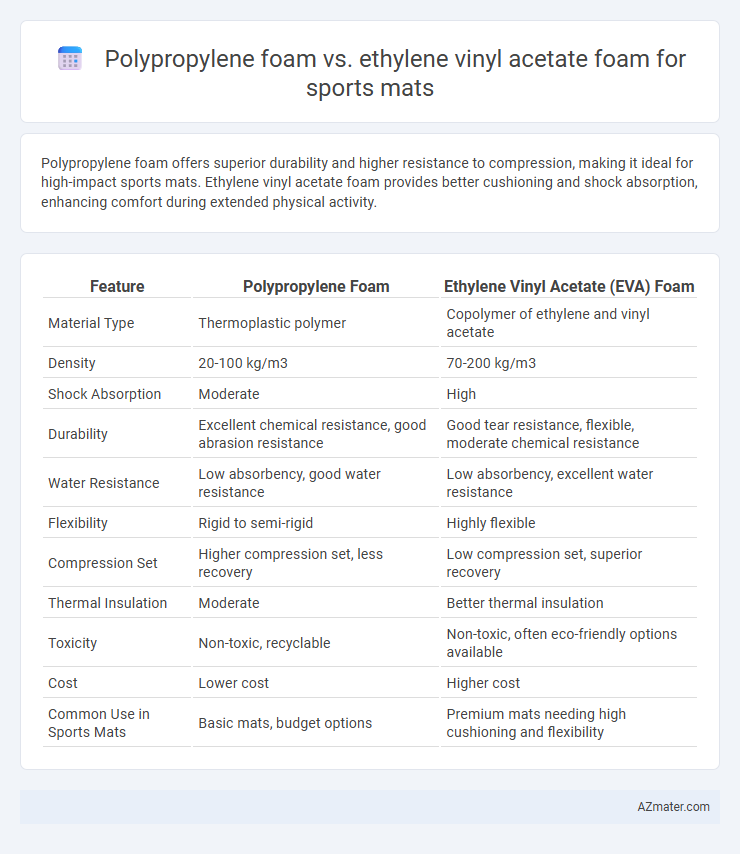Polypropylene foam offers superior durability and higher resistance to compression, making it ideal for high-impact sports mats. Ethylene vinyl acetate foam provides better cushioning and shock absorption, enhancing comfort during extended physical activity.
Table of Comparison
| Feature | Polypropylene Foam | Ethylene Vinyl Acetate (EVA) Foam |
|---|---|---|
| Material Type | Thermoplastic polymer | Copolymer of ethylene and vinyl acetate |
| Density | 20-100 kg/m3 | 70-200 kg/m3 |
| Shock Absorption | Moderate | High |
| Durability | Excellent chemical resistance, good abrasion resistance | Good tear resistance, flexible, moderate chemical resistance |
| Water Resistance | Low absorbency, good water resistance | Low absorbency, excellent water resistance |
| Flexibility | Rigid to semi-rigid | Highly flexible |
| Compression Set | Higher compression set, less recovery | Low compression set, superior recovery |
| Thermal Insulation | Moderate | Better thermal insulation |
| Toxicity | Non-toxic, recyclable | Non-toxic, often eco-friendly options available |
| Cost | Lower cost | Higher cost |
| Common Use in Sports Mats | Basic mats, budget options | Premium mats needing high cushioning and flexibility |
Introduction to Sports Mat Materials
Polypropylene foam and Ethylene vinyl acetate (EVA) foam are popular materials for sports mats due to their cushioning properties and durability. Polypropylene foam offers excellent impact resistance and moisture resistance, making it ideal for high-intensity activities and outdoor use. EVA foam provides superior shock absorption, flexibility, and comfort, widely preferred for yoga mats and indoor sports applications.
Overview of Polypropylene (PP) Foam
Polypropylene (PP) foam stands out for its high impact resistance, lightweight nature, and excellent chemical and moisture resistance, making it ideal for sports mats requiring durability and comfort. Its closed-cell structure provides superior cushioning and shock absorption while maintaining structural integrity under repeated stress. PP foam also offers better thermal insulation and is recyclable, contributing to sustainable sports mat manufacturing.
Overview of Ethylene Vinyl Acetate (EVA) Foam
Ethylene Vinyl Acetate (EVA) foam is a highly popular material for sports mats due to its excellent cushioning, flexibility, and shock absorption properties. EVA foam offers superior resistance to cracking and UV radiation compared to polypropylene foam, making it more durable for outdoor sports applications. Its lightweight structure and closed-cell composition enhance impact protection and water resistance, essential features for high-performance sports mats.
Key Physical Properties: PP vs EVA Foam
Polypropylene (PP) foam offers high rigidity, excellent impact resistance, and superior chemical stability, making it ideal for sports mats requiring durability and structural support. Ethylene vinyl acetate (EVA) foam provides greater elasticity, superior cushioning, and excellent shock absorption, enhancing comfort and reducing injury risk during physical activities. The density of PP foam typically ranges from 30 to 60 kg/m3, whereas EVA foam ranges from 50 to 200 kg/m3, reflecting EVA's higher compressive resilience and energy return properties essential for dynamic sports environments.
Durability and Longevity Comparison
Polypropylene foam offers exceptional durability with high resistance to wear, compression, and chemical exposure, making it ideal for sports mats subjected to intense physical activity. Ethylene vinyl acetate (EVA) foam provides excellent cushioning and flexibility but tends to degrade faster under UV exposure and heavy use, reducing its overall longevity. In comparison, polypropylene foam typically outlasts EVA foam in durability and maintains structural integrity longer in demanding sports environments.
Comfort and Impact Absorption
Polypropylene foam offers excellent impact absorption and durability, making it suitable for high-performance sports mats that require protection against heavy impacts. Ethylene vinyl acetate (EVA) foam provides superior comfort due to its softer, more flexible structure, enhancing cushioning during prolonged use. When choosing between the two, polypropylene foam prioritizes long-term resilience and impact resistance, while EVA foam excels in shock absorption and user comfort for activities involving frequent movement.
Water and Sweat Resistance
Polypropylene foam exhibits superior water and sweat resistance compared to ethylene vinyl acetate (EVA) foam, making it ideal for sports mats used in high-moisture environments. Polypropylene's closed-cell structure prevents water absorption, reducing the risk of mold and odor buildup during intense workouts. EVA foam, while offering cushioning, tends to absorb moisture more readily, which can compromise durability and hygiene over time.
Environmental Impact and Recyclability
Polypropylene foam boasts superior recyclability due to its thermoplastic nature, enabling repeated melting and reshaping without significant degradation, which reduces landfill waste compared to ethylene vinyl acetate (EVA) foam. EVA foam, while offering excellent cushioning and flexibility for sports mats, presents challenges in recycling because of its cross-linked structure that complicates standard recycling processes and often leads to incineration or landfilling. From an environmental impact perspective, polypropylene foam generally exhibits lower greenhouse gas emissions during production and end-of-life processing, making it a more eco-friendly choice for sustainable sports mat applications.
Cost Considerations for Sports Mats
Polypropylene foam offers a cost-effective solution for sports mats, providing durability and resistance to moisture at a lower price point compared to Ethylene Vinyl Acetate (EVA) foam. EVA foam, while generally more expensive, delivers superior cushioning and impact absorption, which can justify the higher initial investment for high-performance sports mats. Budget constraints and performance requirements should guide the choice between polypropylene foam's affordability and EVA foam's enhanced comfort and protection.
Choosing the Right Foam for Your Sports Mat
Polypropylene foam offers superior rigidity and moisture resistance, making it ideal for high-impact sports mats requiring durability and stability. Ethylene vinyl acetate (EVA) foam provides excellent cushioning, flexibility, and shock absorption, enhancing comfort and injury prevention during physical activities. Choosing the right foam depends on the specific sport's demand for impact resistance versus comfort, with polypropylene foam favored for heavy-duty use and EVA foam preferred for versatile, cushioned support.

Infographic: Polypropylene foam vs Ethylene vinyl acetate foam for Sports mat
 azmater.com
azmater.com